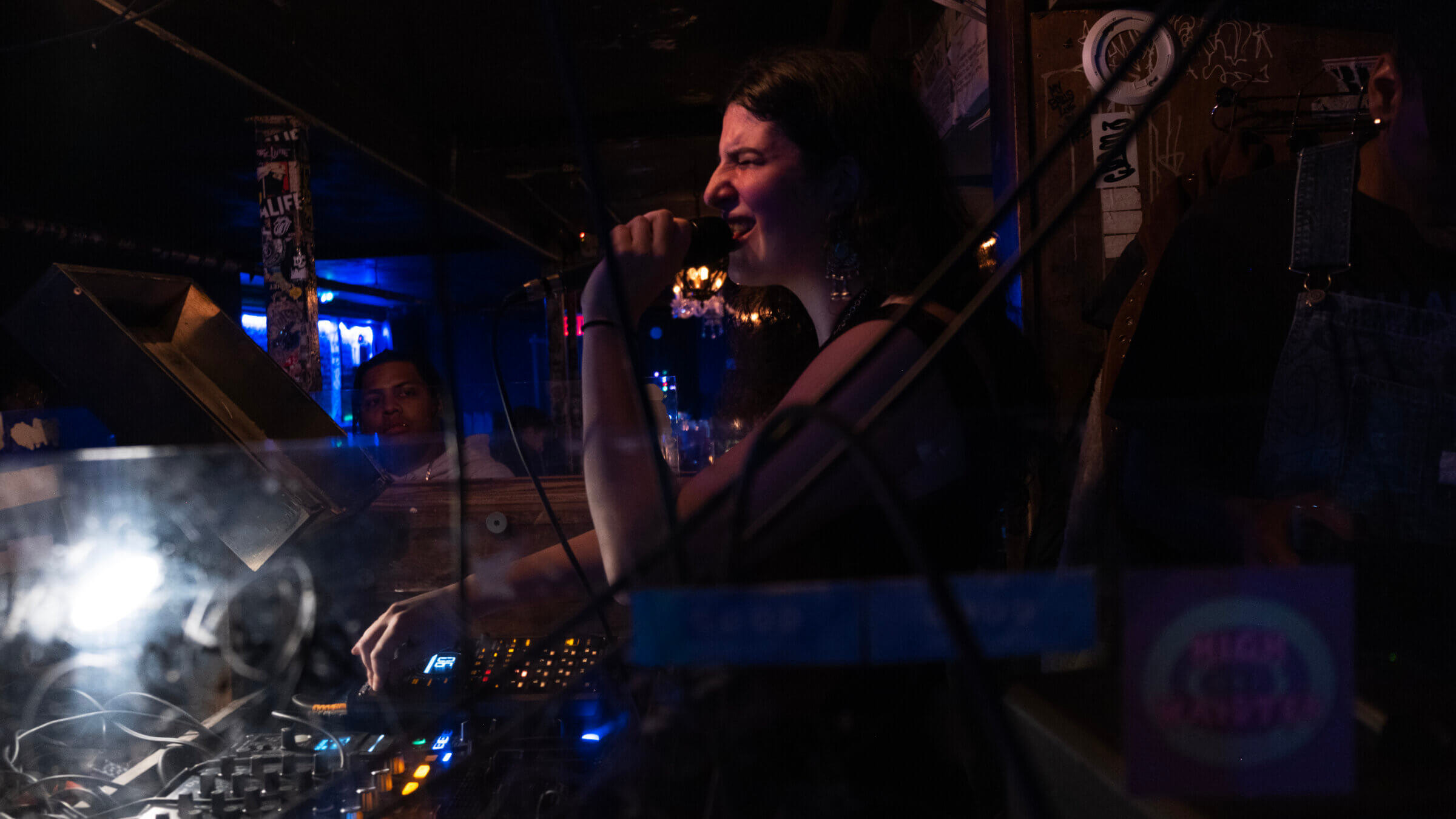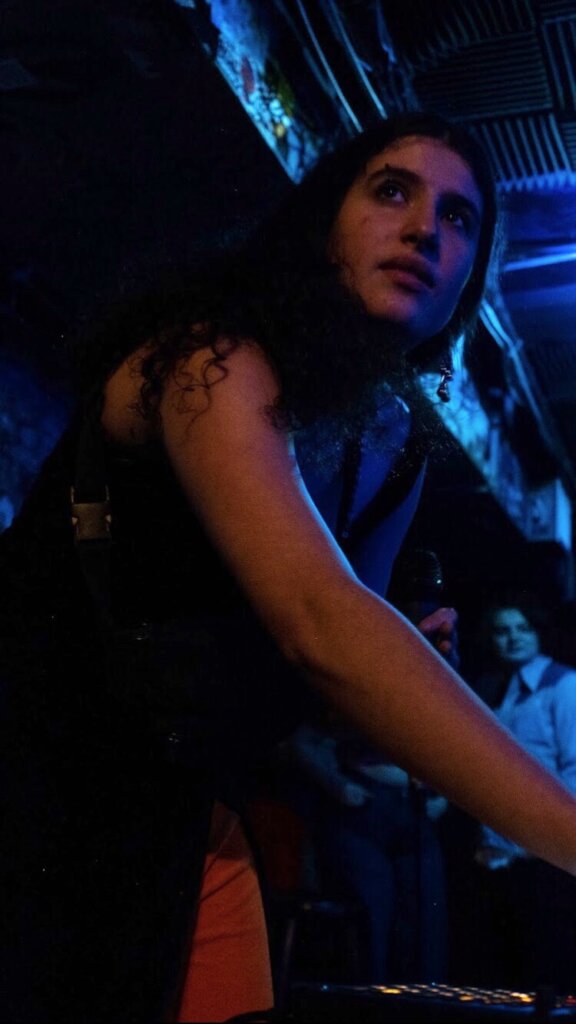Klezmer Techno Music? This 22 Yearold Is Making It A Thing

Kaya Berman-Peters is currently on a gap year from a music program offered jointly by Harvard University and the New England Conservatory of Music. He plans to record his debut album, Kleztronica, this summer. Courtesy of Berman-Peters
It was called Klejtronica. It is mostly electronic dance music with elements of klezmer. The long-established genre is mostly made up of samplers and synths, though live performances also use old-school instruments that don't need to be plugged in. Kaya Berman-Peters, a 22-year-old student from New York, calls the Clajtronica platform "the first of its kind."
To which Josh Dowgin, considered the godfather of klezmer hip-hop, replies: "Up to a certain age everyone thinks they made it all up."
Dugin, a Montreal-based musician who performs under the name Soclaimed, is widely credited for pioneering the integration of samples into klezmer music. During a recent visit to New York, he met Berman-Peters and became convinced that there was now a Klejtronica "scene."
The Jewish EDM scene

Berman-Peters has played three Klejtronica events thus far, beginning with an after party at Yiddish New York in December. Two meetings were held in March: one gathered 500 people for Purim in Boston; Another was at Trans Pecos, an EDM venue in Queens. A second night at Trans Pecos is scheduled for this week and is the result of Clear the Floor, a collaboration with Boston rave collective BIPOC, which curated four of the night's nine acts.
The remaining five works were selected by Berman-Peters. In three of them, the performers used the "they/them" pronouns: Sam Slate, who appeared dressed as the diva Nigun and sang in a Yiddish chorus; Abby Goldberg, who played Chava Goodtime in drag; and Beila Unger, a former dancer who described herself online as "a queer white Ashkenazi Jew." Howard Unger, a klezmer trumpeter from Washington, DC, is the young Unger's father. Berman-Peters described the Klejtronica scene as "a very strange place". She will also perform under her stage name Chaya.
Kleztronica's fifth band on the 20th will be Brooklyn-based multi-instrumentalist Eleanor Weil, who will play an age-old instrument called the "Hardy-Gardy." Although the medieval instrument played strings by turning knobs, its output was routed through a sort of effects processor that guitarists controlled with a footswitch, giving Wheelie the ability to add reverb, vibrato, tremolo, and wah-wah to the sound. Weill calls it his Space Lear because it sounds like "20 aliens playing together."
"It's very raw and intense," he said. "It looks like a wired bagpipe. A lot of people can't handle it."
"Very strange house"
The same can be said for Klejtronic, its strong disco beat borrowed from house music, a genre created by African-American music producers in Chicago in the 1980s. House is known for its so-called four-on-the-floor beat, which involves hitting a bass drum with each beat . Klejtronic's synthesized rhythms and orchestration may seem too mechanical to some klezmer fans.
But Kleztronica's performances have a human factor. Berman-Peters is known for singing along with the music playing from his sampler and has a beautiful voice.
"Creating a home in the diaspora is very important to me, and Klajtronica is that version of me," Berman-Peters told me.
Berman-Peters is currently on a sabbatical from a music program offered jointly by Harvard University and the New England Conservatory of Music. He plans to record his debut album, Kleztronica, this summer. But he doesn't just play klezmer EDM; She sings with the Boston Mama Liga klezmer ensemble and is a member of Levison, a Boston klezmer trio.
"He's a great musician," said Jeff Warsa, a singer and veteran of klezmer music who met Berman-Peters when he was 14 and joined the Columbia University klezmer group he leads.
How Chaya makes her music
Berman-Peters' main "instrument" is the Roland SP 404 MKII, a $500 sampler the size of a hardback book. Although he's been using it for over a year because he plays the accordion, he's used to playing the device's 17 pads that play samples and rhythms.
Voice and voice samples are used in addition to the synthesized instrument sounds played by the sampler. In one piece, he begins a few bars of a hatikva , then distorts it to sound more like editorial comment than creative development. Some of the dialogue is incomprehensible, and not just because it's not in English.
Needle , Klezmer, Needle! In a nearly 12-minute piece on his Soundcloud page, he gives the example of a Holocaust survivor reciting some of the Purim pieces performed door-to-door in Eastern Europe. The sound was part of his performance at the New England Conservatory of Music in May 2022.
In his eight-plus minute track, " Utzu Yetza ", he incorporates spoken word recordings of artists and activists such as Emma Goldman, Jenny Romain, Molly Pickon and Michal Yaszynski, speaking on topics such as gay politics and the treatment of Palestinians. (Berman-Peters has said that she wants to address the "trauma of Zionism" in her music and live performances.)
Pianist Anthony Coleman, who worked with Berman-Peters as a conservatory teacher, said he liked " Utzu Yetza " and compared it to Public Enemy because it deals with "what happens on the street". The Berman-Peters Kleztronica tracks are also reminiscent of some of the radio mixes heard on left-wing stations like WBAI, where breaking news and pop music combine to comment on current politics. Both walk a fine line between agitprop and art.
Coleman has a long history of exploring Jewish music with his bands Sephardic Tingz and The Selffatters. It was Coleman who sampled his friend David Krakow 's "Klezmer Madness" in 1995 ! album. However, he eventually abandoned the sampling technology, disillusioned with his attempts to use abstract words that still hinted at a connection to Judaism. Coleman found that the technology in the 2023 sample was several light-years ahead of existing technology at the time of his sample.
A new era of Jewish house music
"The technology we were working with in the '90s is nothing compared to what you have today when you work with a sample," Coleman said. "There's no comparison. We had to work with such limited memory. And now everything is at your fingertips. Now that it's so easy, what do you do with it?"
While teaching a course at the conservatory called Themes and Trends in American Music, Coleman spent time listening to some of the most successful EDM artists, including Diplo and a couple of Americans named Skrillex. Coleman said that the music on Diplo's records "sounds pretty much the same to me".
But Hankus Netsky, co-head of the contemporary music department at the New England Conservatory of Music and one of Berman-Peters' mentors, believes that despite electronic music's flaws, kleztronica appeals to young people looking for a way to connect with their ethnic roots. And that's something Netsky says the mainstream Jewish community is ignoring.
Immersed in Jewish mysticism.
"Kaya is the perfect person for what she does," Netsky said. "He has a very strong Jewish background. He is deeply involved in Jewish mysticism, which is rarely out there."
Another teacher, Basia Schechter, has known Berman-Peters since childhood. Schechter, a singer best known as the founder and lead singer of the world-famous band Pharaoh's Daughter, remembers Kaya as a child sitting on her father's lap taking classes in Jewish mysticism that he taught at the family home.
"It's starting a new klezmer movement and really bringing it into the 21st century , " Schechter said. "It's not just a genre. It's a way of uniting a certain generation of people. He builds a scene around himself."
Of course, the Berman-Peters creations of the mid-1920s and '30s are not the first klezmerim to use sampling. That was at least 30 years ago.
Frank London, a klezmatics trumpeter, used the samples in his klezmer score for the 1993 documentary The Schwitz . The following year, the samples were part of the mix for the band's album Horned Jews . London is finishing work on a new album for the Borscht Beat label, with recordings that have been stored on her hard drives for more than a decade. According to the label's CEO, Aaron Bendich, it promises to push the boundaries of Jewish EDM. Guitarist Sam De Harmet, responsible for Eleanor Weill's cosmic voice, is involved in mixing the upcoming album.
Krakauer's Klezmer Madness ! Samples reproduced from! The recording, which was the first CD released on the radical Jewish culture label Tzadik Records. Additional samples were used on the subsequent Kraków recording at Klezmar in New York in 1998 .
For an example of how samples can impressively blend the old with the new, listen to Wally Brill's 1997 album The Covenant . It features gritty office samples from the 1920s, '30s and '40s , complemented by a strong synth dance beat.
Although Balkan beatbox only emerged in the mid-2000s, it has made a huge impact by bringing sampling and hip-hop to the world of klezmer.
But no regular on the klezmer scene has used sampling as effectively as Dougin, who came to klezmer via hip-hop.
In 1999 or 2000, Dougin reluctantly visited Claes for the first time in Canada. Not experiencing the expected scene of futility, he used his mini turntable to record samples of some of the klezmer greats in attendance, including Krakauer, the late Pete Sokolov, and Philadelphia drummer Elaine Hoffman Watts.
"That was the key moment that led me to do what I'm doing because his beat was so fun and unique, but it was so much repeated and sampled," Dowgin said of the late drummer.
For over 20 years, Dowgin has recorded many albums, toured with the best klezmer music and written. His status as a promoter of the klezmer scene was such that McGill University hired him to teach a course on Jewish music.
"What surprises me the most is that [the use of klezmer samples] didn't happen until after I did it," Dowgin said. “No one has really taken the gauntlet yet. So it seems that this new generation has the tools and knowledge of old music and new types of dance music to shape this kleztronica scene. It actually turns out to be a scene."
The next Kleztronica is scheduled for July 20 in Trans Pecos.


